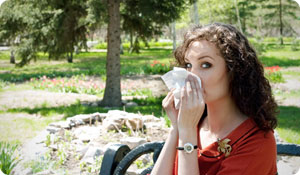
If you love the outdoors and have an affinity for nature, you probably appreciate the trees in your yard and in your neighborhood. Trees bring a variety of important benefits, such as producing oxygen in the air, lowering carbon dioxide levels, preventing soil from eroding, and helping to control ground temperatures.
But if you suffer from seasonal tree pollen allergies, you may find that some trees can also make you feel pretty miserable.
When Tree Pollen Allergies Exist
You probably associate your seasonal allergies with grass, plants, and weeds, but in addition to these common triggers, some types of trees can also make your eyes itch and cause you to sneeze. Furthermore, trees usually produce the first pollen of the season, bringing on your discomfort with the onset of spring.
Beware of these Trees
There are an estimated 50,000 different tree types today, but in fact, only about 100 of these produce the pollen that can make you sick. Here is a sampling of the larger list:
- Elm
- Olive
Sycamore - Walnut
- Hickory
- Pecan
Gender Matters
Certain types of trees actually discriminate by gender, with only the male (not the female) of the species releasing allergy-causing pollen into the air. These include:
- Maple (red and silver)
- Willow
- Ash
- Poplar
- Cottonwood
- Box Elder
Tree Pollen Travels
It's also important to note that if you suffer from tree allergy symptoms but don't think you have any pollen-producing trees in your yard of nearby vicinity, the allergen may be traveling quite a distance. This is because tree pollen can be carried by the wind for many miles, meaning that you don't need to see the tree to experience the full force of its affects.
Coping with a Tree Allergy
With the range of allergy-causing trees that exist and the distance the pollen can travel, determining exactly which type of tree is to blame, and what you can do about it, can prove quite a challenge. Often undergoing allergy testing is the only way to find out for sure exactly what's triggering your immune system into over-action.
In the meantime, you can make some of these easy changes to try to minimize your tree allergy symptoms.
- Plant only non-allergic trees in your yard. You can ask a landscaper or local nursery to offer some recommendations.
- Avoid planning outdoor activities for early mornings and warm, windy days. These are when pollen is at its highest.
- Keep your car and home windows closed, run your air conditioner to filter out tree pollen and other triggers.
- Take a shower and wash your clothes after spending time outdoors to remove any allergens lingering there.
- Take allergy medication as needed to prevent and treat your symptoms.
Sources
American Academy of Allergy, Asthma and Immunology (AAAAI)
http://www.aaaai.org/patients/publicedmat/tips/outdoorallergens.stm
http://www.aaaai.org/patients/advocate/2006/spring/gardening.asp
National Institute of Environmental Health Sciences
http://www.niehs.nih.gov/health/topics/conditions/asthma/pollen.cfm





